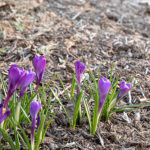Stones or mulch in your landscape beds?

You’ve just installed your plant material and now it’s time to decide which material to use to cover the soil. The two most common materials are mulch and stone. Aesthetic preferences aside, here are some pros and cons for each.
We’ll start with stone. Starting with the pros, stone does not break down and need replacing. Also, you have few issues with weeds initially due to the use of weed barrier fabric. One of the problems with stone is that it is much more expensive to install, though some would argue that the upfront costs are offset by the fact that it doesn’t have to be replaced annually.

The primary issues are maintenance. Though weed barrier is effective in the short term, eventually a layer of dust and plant material create a medium on top of the fabric that weeds can and will grow in. This can be mitigated somewhat by careful cleaning of the beds (the heavier the stone the better for cleaning), but eventually weeds will become a real problem.

Physically removing weeds is difficult. Chemical removal is an option, but then you still have to struggle to remove them once they’ve died. Also, stone does not benefit the landscape planting in any way, and though weed barrier fabric is designed to allow water to get through, if there is any kind of slope, more water will run off than soak in compared to not using it. Over time the fabric may degrade or show through, then you can have a real mess.

Also, stone in a sunny location can get uncomfortably hot for some plants. Adding or removing plants, as well as working on irrigation, becomes more difficult in a stone bed. For many though, the aesthetic value is worth any complications.
With mulch, I will start with the cons. It does have to be replaced as it breaks down. If you replace it yearly for aesthetic reasons, the old mulch might need to be removed to prevent a harmful build up. We've all seen towering cones of much piled against tree trunks, and it is not a good thing.

If you wait for it decompose sufficiently, removal of the old mulch may not be necessary. Mulch is also susceptible to more weed growth initially than stone, though the weeds are easier to remove physically. Mulch can become matted as the season progresses causing some water runoff, but a quick fluffing or cultivating of the mulch will break up mats to restore proper absorption. The best thing about mulch is its benefit to the plant material.

Mulch is good for water retention in the soil, provided there’s enough water to permeate the mulch in the first place. Mulch also provides a good environment for beneficial insects, fungi, and microbes in the soil. Some amount of nutrients are also made available to the plants as the mulch decomposes. Mulch also provides insulation for plant roots that is effective in hot and cold conditions.

Badly degraded landscape fabric around a street tree.
It is a waste of money to use weed barrier fabric under mulch as you are defeating the purpose by immediately placing a medium in which weeds can grow on top of it.
Here's a quick recap of the pros and cons of each material:
Pros, Stone
- Does not break down
- Does not need to be replaced
- Can use landscape fabric underneath
Cons, Stone
- More expensive initially
- Weeds harder to control and remove
- Does not benefit plants
- Can be too hot for some plants
- Landscape fabric can inhibit water penetration
- Landscape fabric can degrade
- Needs periodic cleaning of debris
Pros, Mulch
- Weeds easy to remove
- Easy to fluff and refresh
- Helps retain soil moisture
- Provides environment for beneficial soil organisms
- Feeds plants as it breaks down
- Insulates roots from weather extremes
Cons, Mulch
- Needs to be replaced or refreshed
- Can be piled too deep for the health of plants in the beds
- Weeds may grow easily
- Can mat down
Stone or mulch? The final decision I leave to you.

